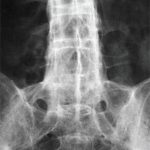ERAP1 is involved in trimming peptides to optimal length for binding to HLA class 1 molecules, thereby not only affecting the stability and processing of HLA-B27 but also influencing the peptide repertoire presented to the immune system. It appears likely that the pathogenic effect of ERAP1 may be mediated through effects on innate immunity, such as altering the interaction between HLA-B27 and immune receptors or via the endoplasmic reticulum unfolded protein response.9
Hiding in Plain Sight
For many patients and their clinicians, making the diagnosis of AS can remain elusive. The clues are not necessarily found at the bedside. Instead, they may be lurking elsewhere, hiding somewhere in the patient’s history. Before we look, we must listen. Is the pain worse with rest and better with activity? Was there a robust response to NSAIDs? Is there a family history of a spondyloarthritis?
The true number of patients with AS and related forms of inflammatory back disease is hard to ascertain. One recent study from the Netherlands estimated that nearly one-quarter of relatively young patients with chronic back pain seen in primary care practices suffer from an undiagnosed spondyloarthritis.10
I recently met a patient who was referred to me for further management of his recently diagnosed AS. Phil, a recently retired Wall Street financier, kept active by skiing in Wyoming and fox hunting in Delaware. After falling off his horse during a particularly intense fox chase, his world nearly came to a crashing end. It took a neurosurgeon six hours to meticulously repair Phil’s three fractured cervical vertebrae and stanch the profuse bleeding. He told Phil he was a “tough case” because of his AS. What?
Phil was baffled. He had never heard of AS before. Yes, he realized that he walked stiffly, “sort of like Ed Sullivan,” but he attributed this to having tight muscles. None of his doctors contradicted this theory, although Phil couldn’t remember ever having his back carefully examined. When I asked him, he recalled suffering through two prior episodes of uveitis. But neither his ophthalmologist nor his Upper East Side (N.Y.) concierge internist tied all of these can’t miss clues together. They just lay there, buried in his medical records; disparate bits of clinical information waiting for someone in an operating room to lasso together.
Simon M. Helfgott, MD, is associate professor of medicine in the division of rheumatology, immunology and allergy at Harvard Medical School in Boston.



